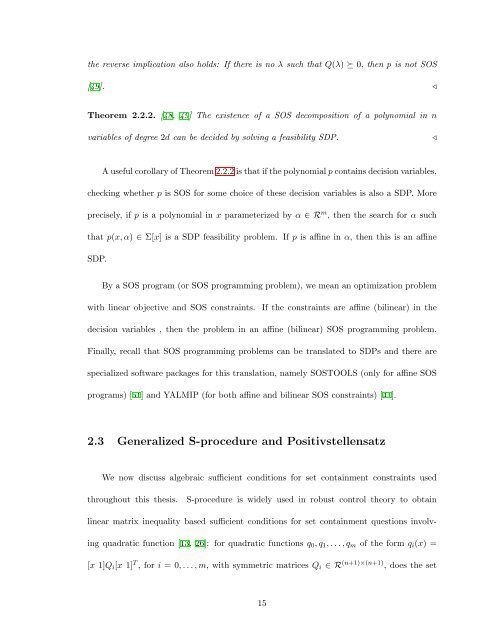Quantitative Local Analysis of Nonlinear Systems - University of ...
Quantitative Local Analysis of Nonlinear Systems - University of ...
Quantitative Local Analysis of Nonlinear Systems - University of ...
You also want an ePaper? Increase the reach of your titles
YUMPU automatically turns print PDFs into web optimized ePapers that Google loves.
the reverse implication also holds: If there is no λ such that Q(λ) ≽ 0, then p is not SOS<br />
[49]. ⊳<br />
Theorem 2.2.2. [48, 49] The existence <strong>of</strong> a SOS decomposition <strong>of</strong> a polynomial in n<br />
variables <strong>of</strong> degree 2d can be decided by solving a feasibility SDP.<br />
⊳<br />
A useful corollary <strong>of</strong> Theorem 2.2.2 is that if the polynomial p contains decision variables,<br />
checking whether p is SOS for some choice <strong>of</strong> these decision variables is also a SDP. More<br />
precisely, if p is a polynomial in x parameterized by α ∈ R m , then the search for α such<br />
that p(x, α) ∈ Σ[x] is a SDP feasibility problem. If p is affine in α, then this is an affine<br />
SDP.<br />
By a SOS program (or SOS programming problem), we mean an optimization problem<br />
with linear objective and SOS constraints.<br />
If the constraints are affine (bilinear) in the<br />
decision variables , then the problem in an affine (bilinear) SOS programming problem.<br />
Finally, recall that SOS programming problems can be translated to SDPs and there are<br />
specialized s<strong>of</strong>tware packages for this translation, namely SOSTOOLS (only for affine SOS<br />
programs) [51] and YALMIP (for both affine and bilinear SOS constraints) [41].<br />
2.3 Generalized S-procedure and Positivstellensatz<br />
We now discuss algebraic sufficient conditions for set containment constraints used<br />
throughout this thesis.<br />
S-procedure is widely used in robust control theory to obtain<br />
linear matrix inequality based sufficient conditions for set containment questions involving<br />
quadratic function [13, 26]: for quadratic functions q 0 , q 1 , . . . , q m <strong>of</strong> the form q i (x) =<br />
[x 1]Q i [x 1] T , for i = 0, . . . , m, with symmetric matrices Q i ∈ R (n+1)×(n+1) , does the set<br />
15













